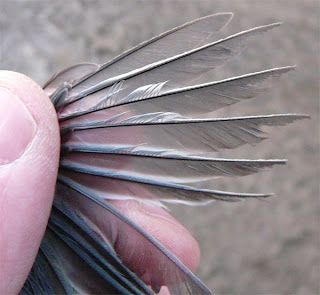Things have got off to a slow start this year bird ringing wise due to some extremely wet and windy weather conditions, and so birding has been the primary activity for me, when work has allowed. But this weekend the weather changed and so it was back down to Manor Farm Country Park. Unfortunately the ridiculously mild winter this year has meant that birds are pretty thin on the ground, and after two sessions, one Saturday afternoon and the other Sunday morning I managed the measly total of 29 birds of 10 species. As always there are highlights, and today they were 3 Bullfinch's, 2 Redwings, and a Song Thrush, whereas Saturday's highlight was a fly over Red Kite, rather than any captured birds.
 |
| First Year Blue Tit |
Since I have discussed Bullfinch and Redwing in previous posts, and with not much else to mention, I thought I would run through aging Blue Tits. Blue Tits, and Great Tits for that matter, are relatively straight forward to age since their moult strategy follows that of the majority of European passerines, with adult birds having a complete moult after breeding whereas first year birds undergo a partial moult.
 |
| Wing of First Year Blue Tit Showing Contrast |
The result of this moult strategy is a usually very obvious contrast between the alula and primary coverts, with the these feathers being a dull blue-green in colour as opposed to the bright blue greater coverts. Adult wings are uniform bright blue throughout.
 |
| Wing of First Year Blue Tit Showing Contrast |
In addition, first year tail feathers are also a duller blue colouration, are more pointed, and by mid-winter they are often more abraded. Adult tail feathers are again brighter, more rounded and often have a distinct white edge at the tip. The image below illustrates this perfectly with a mixture of both adult and juvenile tail feathers, 1 adult feather is still growing, and the presence of this helps identify the others.
 |
| Tail of Blue Tit Showing Adult and Juvenile Feathers |
The wing of one of the birds captured was so badly abraded that when it was released its flight was extremely weak and flappy.
 |
| Abraded Wing of First year Blue Tit |
Given that this bird is not due to moult until after the breeding season in July, and looking at the condition of the wing feathers, it is hard to image how this bird will be able to efficiently feed until it next moults.
First time visit, beautiful photographs and interesting article, will make sure I visit again. Great work barleyman!
ReplyDeleteare you still colour ringing HOUSPs?
ReplyDeleteHi Tim, yep using yellow darvic rings with three letters on..check out earler post on Manor Farm
ReplyDelete